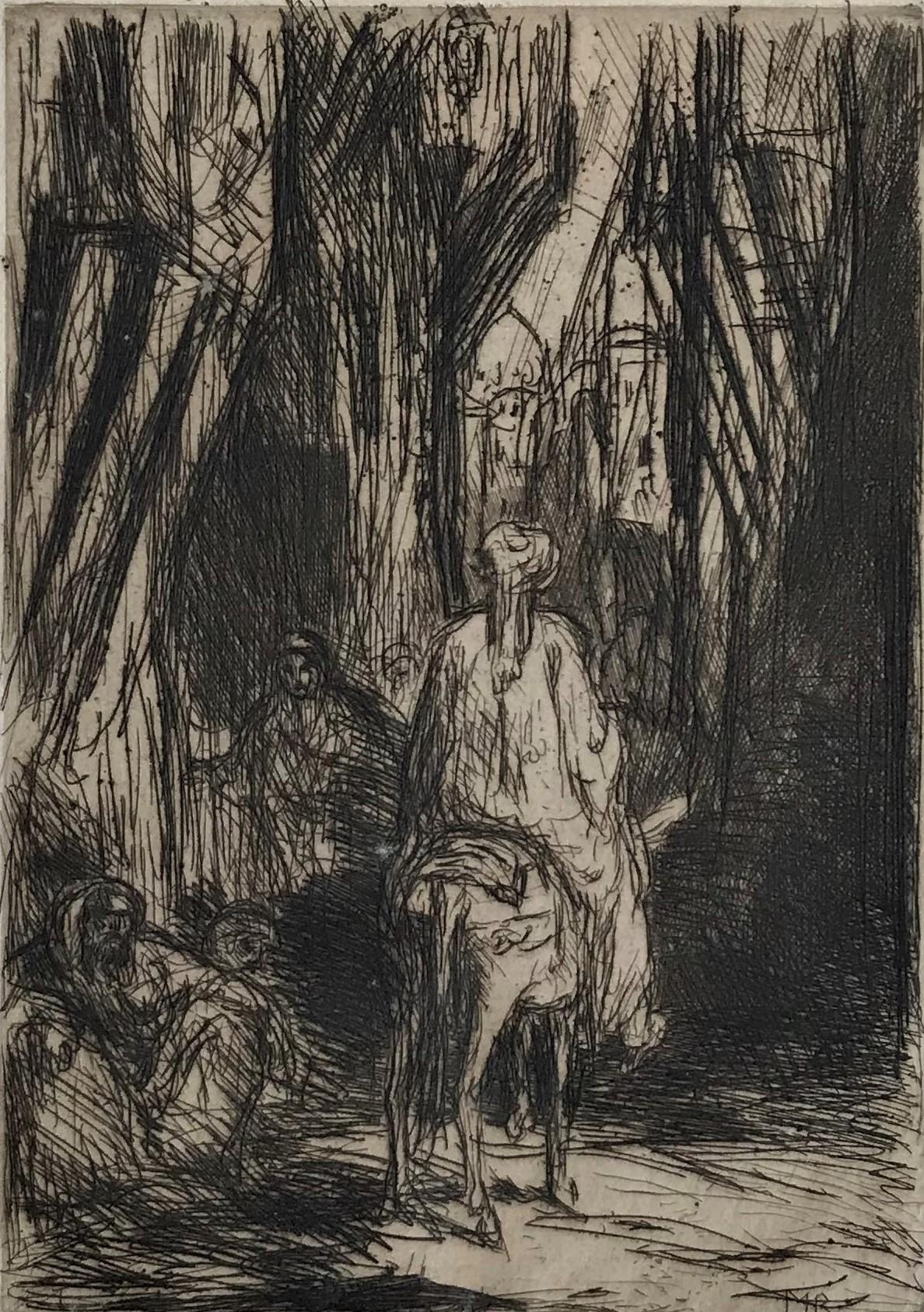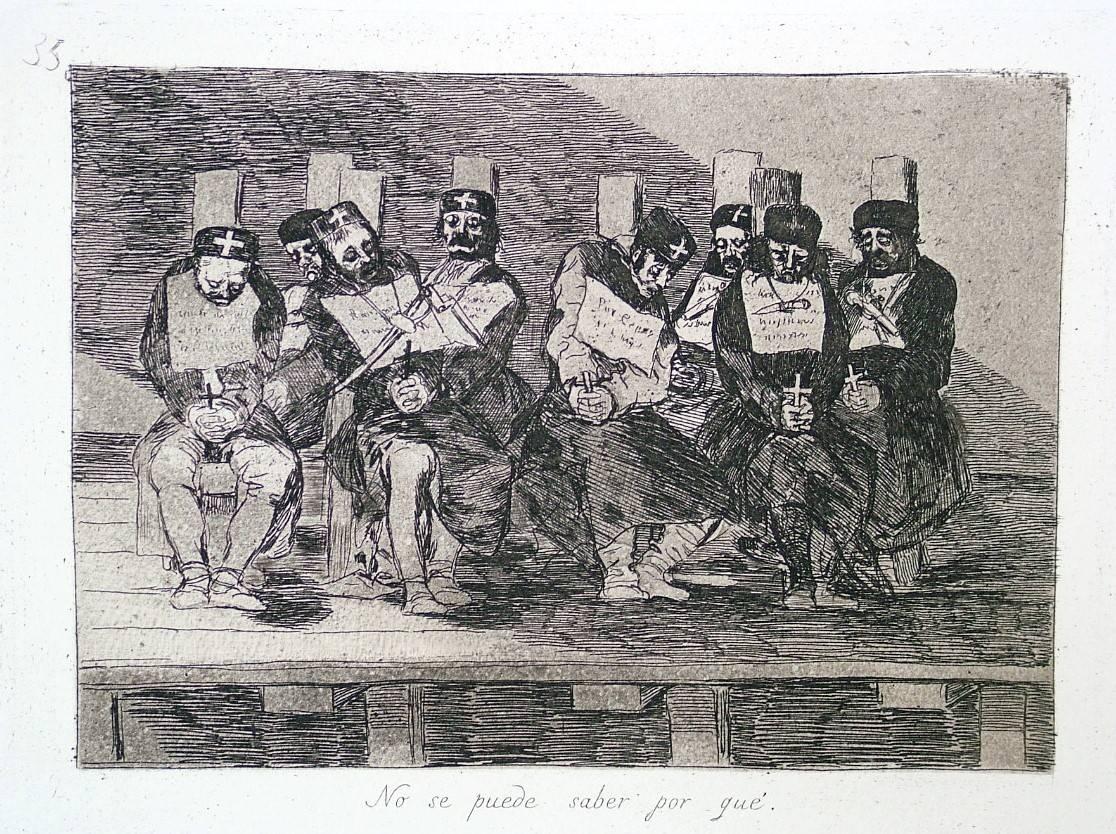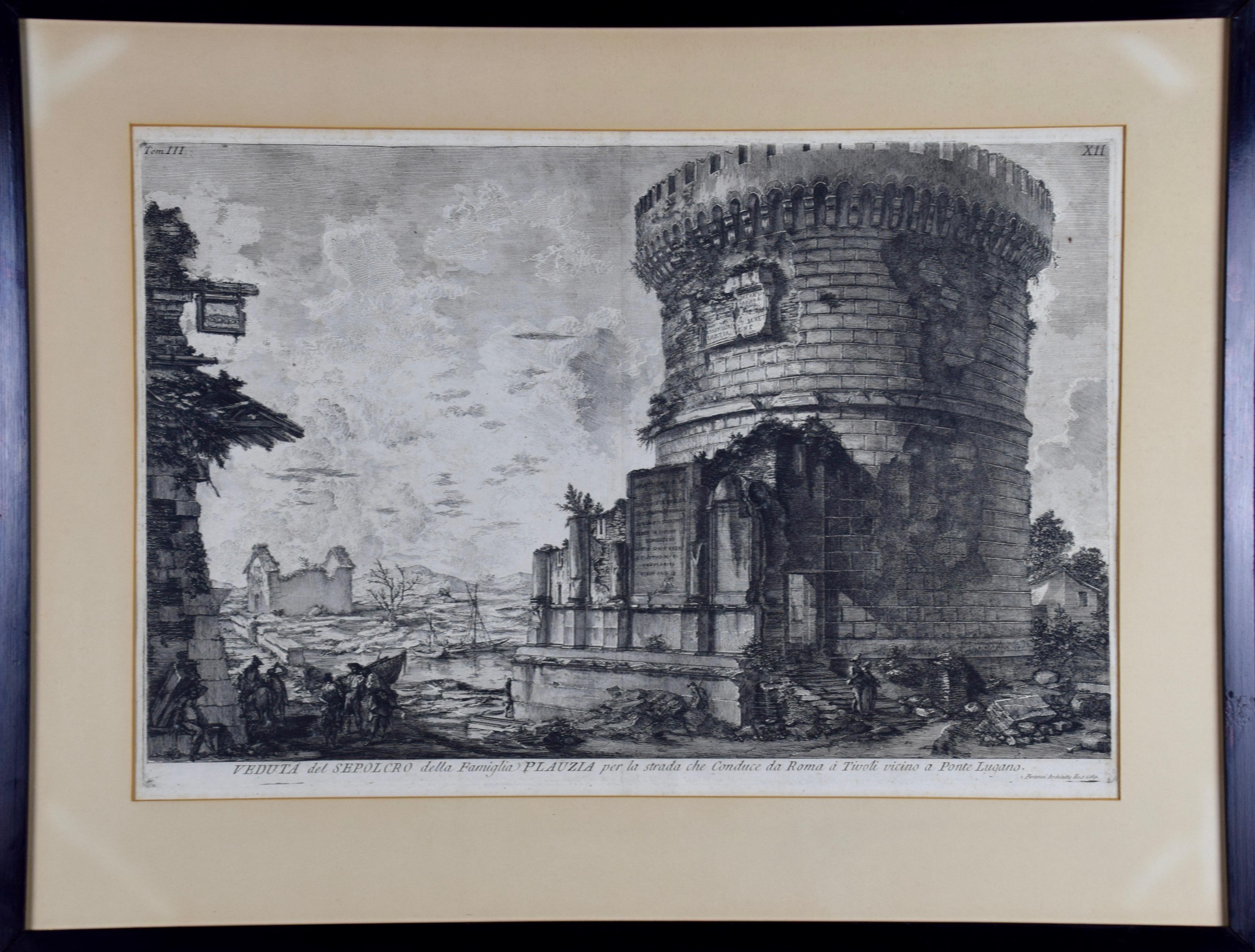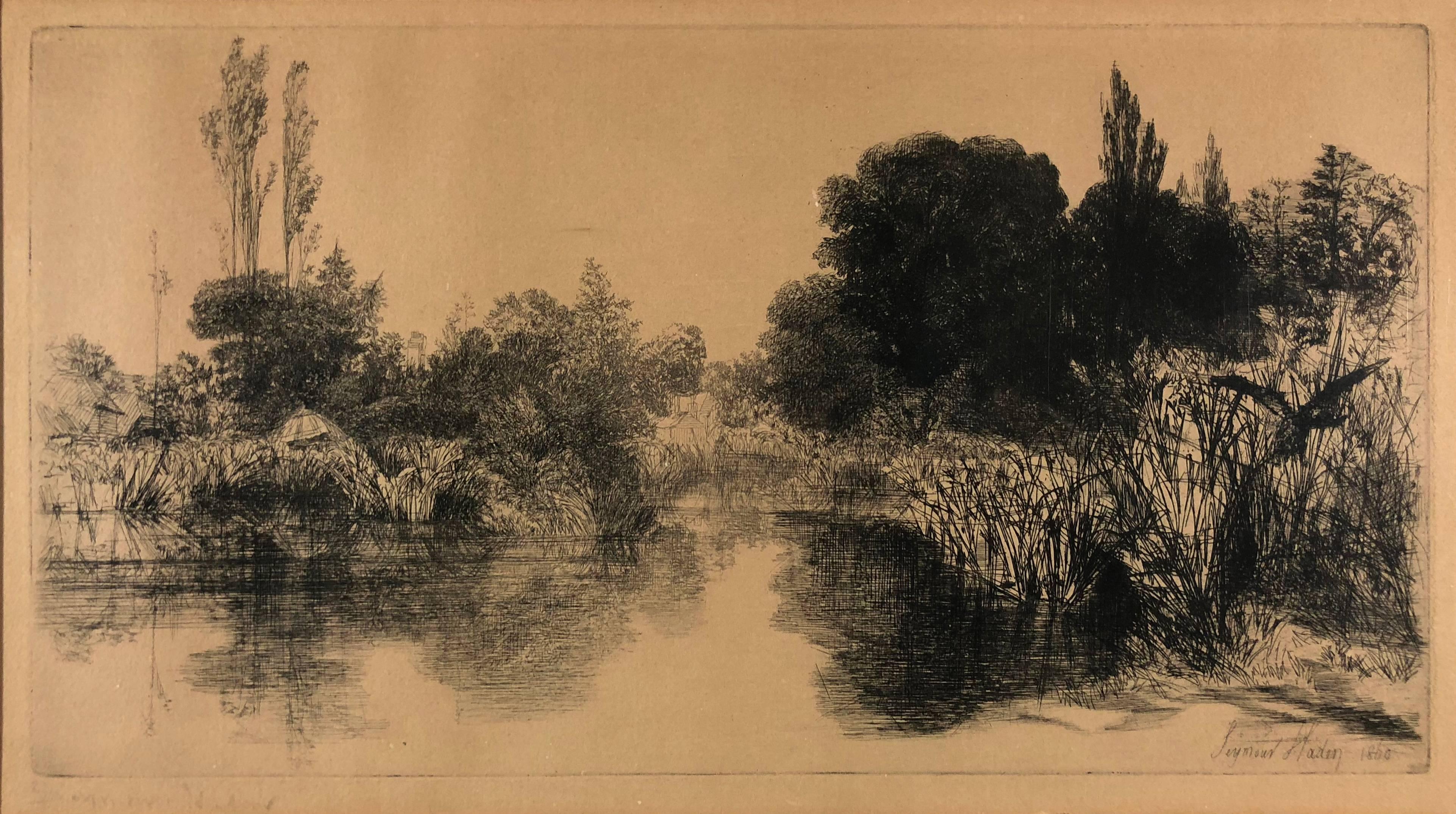Items Similar to Death Appearing to a Wedded Couple from an Open Grave
Want more images or videos?
Request additional images or videos from the seller
1 of 4
Rembrandt van RijnDeath Appearing to a Wedded Couple from an Open Grave1639
1639
About the Item
REMBRANDT HARMENSZ. VAN RIJN
1606 Leiden Amsterdam 1669
Death Appearing to a Wedded Couple from an Open Grave 1639
drypoint and etching; 109 x 78 mm
Bartsch 109, White/Boon only state; Hind 65; New Hollstein 174, only state
PROVENANCE: extensive provenance history available on request.
Although the themes of love and death were very popular in seventeenth-century Dutch art, the motifs were usually disguised. This very direct confrontation harks back to such earlier representations as Drers Promenade (Meder 83). Accordingly, the figures themselves are clothed in sixteenth-century costume and seem to be amused rather than frightened by the skeleton before them.
This is an extraordinarily good impression of a delicately wrought plate, with all the very finest lines intact (see, for instance, the lightest lines of her flowing hair, and the proving marks below the borderline), with touches of burr, especially towards the bottom. In later impressions, the sharpness of the lines diminishes, the finest lines break or even disappear. Esdailes impression, now at the Metropolitan, is better than the Morgans, but again there are no light scratches below the border, the hair is weak and there is no burr.
Such is the quality of line, in fact, that the characteristics of both this and the other impressions lead one to suspect that the print may be wholly executed in drypoint.
Even early commentators in the eighteenth century have described this print as rare.
[Note: I’m indebted to colleague Armin Kunz for these notes on this fine print]
- Creator:Rembrandt van Rijn (1606 - 1669, Dutch)
- Creation Year:1639
- Dimensions:Height: 42.92 in (109 cm)Width: 30.71 in (78 cm)Depth: 0.04 in (1 mm)
- Medium:
- Movement & Style:
- Period:1630-1639
- Condition:
- Gallery Location:New York, NY
- Reference Number:1stDibs: LU515313494972
Rembrandt van Rijn
Rembrandt was the most influential 17th Century Dutch painter. After years of early success as a portrait painter, his life was beset by financial hardship and personal tragedy. He continued to paint portraits and develop etchings. Rembrandt's portraits of his contemporaries, self-portraits and illustrations of scenes from the Bible are regarded as his greatest creative triumphs. His self-portraits form a unique and intimate autobiography, in which the artist surveyed himself without vanity and with the utmost sincerity. Like many artists of the Dutch Golden Age, such as Jan Vermeer of Delft, Rembrandt was also an avid art collector and dealer. Rembrandt never went abroad, but he was considerably influenced by the work of the Italian masters and Netherlandish artists who had studied in Italy, like Pieter Lastman, the Utrecht Caravaggists, Flemish Baroque, and Peter Paul Rubens. Rembrandt's foremost contribution in the history of printmaking was his transformation of the etching process from a relatively new reproductive technique into a true art form, along with Jacques Callot. His reputation as the greatest etcher in the history of the medium was established in his lifetime and never questioned since. Few of his paintings left the Dutch Republic while he lived, but his prints were circulated throughout Europe, and his wider reputation was initially based on them alone.
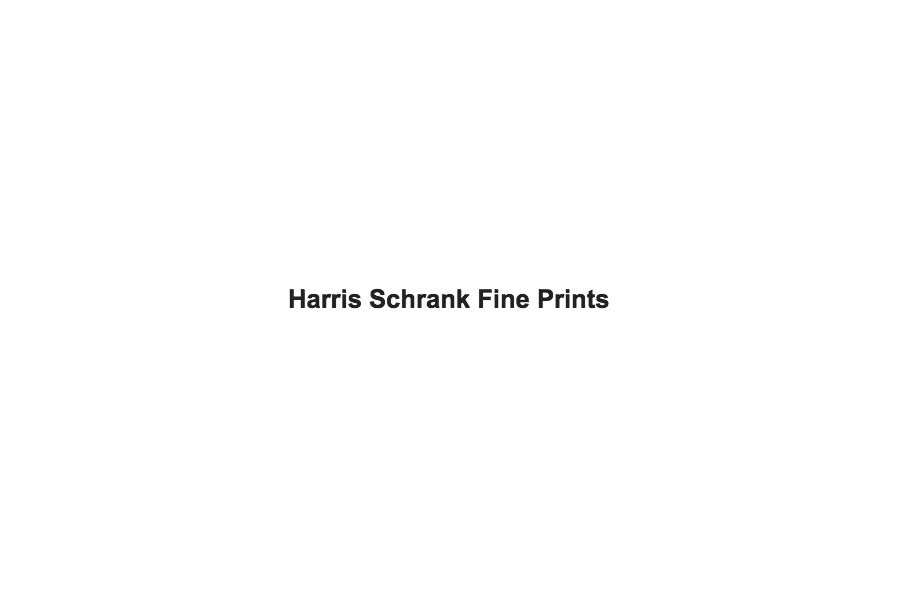
About the Seller
4.9
Recognized Seller
These prestigious sellers are industry leaders and represent the highest echelon for item quality and design.
Established in 2000
1stDibs seller since 2016
100 sales on 1stDibs
Typical response time: 3 hours
Associations
International Fine Print Dealers Association
- ShippingRetrieving quote...Ships From: New York, NY
- Return PolicyA return for this item may be initiated within 7 days of delivery.
More From This SellerView All
- One Can't Tell Why - Proof from the Disasters of WarBy Francisco GoyaLocated in New York, NYFrancisco José de Goya y Lucientes (1746 Fuendetodos – Bordeaux 1828), No se puede saber por qué – One can’t tell why ca. 1808–1814, etching, burnished aquatint, drypoint, an...Category
1810s Old Masters Figurative Prints
MaterialsDrypoint, Etching, Aquatint
- Descending from the Cross, by TorchlightBy Rembrandt van RijnLocated in New York, NYRembrandt Harmensz. van Rijn 1606 Leiden – Amsterdam 1669 The Descent from the Cross by Torchlight 1654 etching and drypoint; sheet 213 x 163 mm (8 3/8 x 6 7/16 inches) Bart...Category
17th Century Old Masters Figurative Prints
MaterialsDrypoint, Etching
- Le Bourg de BatzBy William Strang, R.A., R.E.Located in New York, NYWilliam Strang (1859-1921), Le Bourg de Batz, etching and drypoint on copper, 1913, signed in pencil lower right [also signed and dated in the plate]. Refere...Category
1910s Realist Landscape Prints
MaterialsDrypoint, Etching
- Minne Playing with a Cat (Minne Jouant avec un Chat)By Jacques VillonLocated in New York, NYJacques Villon (1875-1963) etching, aquatint, and drypoint, Minne Playing with a Cat (Minne Jouant avec un Chat),1907, signed in pencil and numbered (12/30)(Ginestet and Pouillon 192...Category
Early 1900s Impressionist Figurative Prints
MaterialsDrypoint, Etching, Aquatint
- Etching for Stephen Spender “Fraternity”By Wassily KandinskyLocated in New York, NYWassily Kandinsky (1866-1944), Etching for Stephen Spender “Fraternity”, etching and drypoint, 1939, signed in pencil lower right. Reference: Roethel 202, only state. From the editio...Category
1930s Abstract Geometric Abstract Prints
MaterialsDrypoint, Etching
- La Fumee du BateauBy Jean-Francois RaffaelliLocated in New York, NYJean-François Raffaëlli (1850-1924), La Fumee du Bateau, color etching and drypoint, 1911, signed and numbered in pencil lower right. Reference: Delteil 98. In very good condition, ...Category
1910s Realist Landscape Prints
MaterialsDrypoint, Etching
You May Also Like
- Street in SmyrnaBy Marius BauerLocated in Storrs, CTStreet in Smyrna. 1889. Etching. Wisselingh 34. 7 x 5 1/4 (sheet 12 7/8 x 8 7/8).Edition 100, number 49. A rich, tonal impression printed on Strasbourg cream laid paper on the full s...Category
Late 19th Century Old Masters Figurative Prints
MaterialsDrypoint, Etching
- COTTAGE AND OBELISK ON THE SPAARNDAMMERDIJKBy Rembrandt van RijnLocated in San Francisco, CAOriginal etching and drypoint printed in black ink on laid paper. A strong and dark 17th century/lifetime impression of Bartsch, Usticke and New Hollstein’s second and final stat...Category
18th Century and Earlier Old Masters Landscape Prints
MaterialsDrypoint, Etching
- Giovanni Piranesi Etching of Ancient Roman Architecture, 18th CenturyBy Giovanni Battista PiranesiLocated in Alamo, CA"Veduta del Sepolcro della Famiglia Plauzia per la Strada Che Conduce da Roma a Tivoli vicino a Ponte Lugano" from "Le Antichità Romane" (Roman Antiquities), one of the most famous works by Piranesi. "Antichita" illustrates the tombs along the Appian Way...Category
Early 18th Century Old Masters Figurative Prints
MaterialsDrypoint, Engraving, Etching
- Shere Mill PondBy Sir Francis Seymour Haden, R.A.Located in Missouri, MOShere Mill Pond, No. II (large plate). 1860. Etching and drypoint. Schneiderman 37.v/ix. 7 x 13 1/8 (sheet 10 3/4 x 16 3/8). This state is prior to publication in Études à l'Eau-Forte. Illustrated: Keppel The Golden Age of Engraving; Print Collector's Quarterly 1 (1911): 18; : Guichard, British Etchers, 1850-1940. A rich, brilliant proof with drypoint burr printed on white laid paper. Signed in pencil. ------------------------------------------------------------------------------------------- Shere Mill Pond, No. II was one of the most highly praised landscape prints of the etching revival. An impression was exhibited at the Royal Academy in 1861 under Haden’s pseudonym, H. Dean. Francis Seymour Haden used this anagram of his own name early in his career as an artist, in order to retain his anonymity and preserve his professional reputation as a surgeon. Biography: Sir Francis Seymour Haden (16 September 1818 - 1 June 1910), was an English surgeon, best known as an etcher. He was born in London, his father, Charles Thomas Haden, being a well-known doctor and lover of music. He was educated at Derby School, Christ's Hospital, and University College, London, and also studied at the Sorbonne, Paris, where he took his degree in 1840. He was admitted as a member of the College of Surgeons in London in 1842. In 1843-1844, with his friends Duval, Le Cannes and Colonel Guibout, he travelled in Italy and made his first sketches from nature. Haden attended no art school and had no art teachers, but between 1845 and 1848 he studied portfolios of prints belonging to a second-hand dealer named Love, who had a shop in Bunhill Row, the old Quaker quarter of London. Arranging the prints in chronological order, he studied the works of the great original engravers, Albrecht Dürer, Lucas van Leyden and Rembrandt. These studies, besides influencing his original work, led to his important monograph on the etched work of Rembrandt. By lecture and book, and with the aid of the memorable exhibition at the Burlington Fine Arts Club in 1877, he tried to give a true reflection of Rembrandt's work, giving a nobler idea of the master's mind by taking away from the list of his works many dull and unseemly plates that had long been included in the lists. His reasons were founded upon the results of a study of the master's works in chronological order, and are clearly expressed in his monograph, The Etched Work of Rembrandt critically reconsidered, privately printed in 1877, and in The Etched Work of Rembrandt True and False (1895). Haden's printmaking was invigorated by his much younger brother-in-law, James Whistler, at the Haden home in Sloane Street in 1855. A press was installed there and for a while Haden and Whistler collaborated on a series of etchings of the Thames. The relationship and project did not last. Haden followed the art of original etching with such vigour that he became not only the foremost British exponent of that art but brought about its revival in England. His strenuous efforts and perseverance, aided by the secretarial ability of Sir WR Drake, resulted in the foundation of the Royal Society of Painter-Etchers and Engravers. As president he ruled the society with a strong hand from its first beginnings in 1880. Notwithstanding his study of the old masters of his art, Haden's own plates were very individual, and are particularly noticeable for a fine original treatment of landscape subjects, free and open in line, clear and well divided in mass, and full of a noble and dignified style of his own. Even when working from a picture his personality dominates the plate, as for example in the large plate he etched after J.M.W. Turner's "Calais Pier," which is a classical example of what interpretative work can do in black and white. Of his original plates, more than 250 in number, one of the most notable was the large "Breaking up of the Agamemnon." An early plate, rare and most beautiful, is "Thames Fisherman". "Mytton Hall" is broad in treatment, and a fine rendering of a shady avenue of yew trees leading to an old manor-house in sunlight. "Sub Tegmine" was etched in Greenwich Park in 1859; and "Early Morning--Richmond", full of the poetry and freshness of the hour, was done, according to Haden, actually at sunrise. One of the rarest and most beautiful of his plates is "A By-Road in Tipperary"; "Combe Bottom" is another; and "Shere Mill Pond" (both the small study and the larger plate), "Sunset in Ireland," "Penton Hook," "Grim Spain" and "Evening Fishing, Longparish," are also notable examples of his genius. A catalogue of his works was begun by Sir William Drake and completed by Harrington in 1880. During later years Haden began to practise the sister art...Category
Late 19th Century Old Masters Landscape Prints
MaterialsEtching, Drypoint
- The Sacrifice of IphigeniaBy Nicolas BeatrizetLocated in Roma, ITBlack and white etching and drypoint on wire rod paper, representing the myth of the sacrifice of Iphigenia. On the altar is inscribed "Iphigenia" in capital letters. On the lower left margin is inscribed "N. Beatrizet Lo Taringus F.", slightly discolored (Beatrizet usually signed his plates with the letters "N. B. L. F."). At the center of the lower margin is inscribed "Romae, Michaelis Tramezini formis cum privilegio summi Pont. M.D.L.III". After a drawing attributed to either Michelangelo Buonarroti, Salviati, or Baccio Bandinelli...Category
16th Century Old Masters Figurative Prints
MaterialsDrypoint, Etching
- Breaking up of the Agamemnon, No 1By Sir Francis Seymour Haden, R.A.Located in Storrs, CTEtching and drypoint. Schneiderman 133.v/xi. 7 3/4 x 16 3/8 (sheet 9 1/4 x 17 1/2). A rich impression with plate tone printed in black/brown in on antique cream wove paper. Signed in pencil. In this state, according to Schneiderman (p. 273):"With additional etched work: an extra balk of timber has been added to the balk in the right foreground (the tip of which is approx. 135 mm. from the right plate mark and 35 mm. from the bottom); the barges made darker, and there are drypoint touches in the water in front of the stern. The extreme left line of the hoist of the wrecking barge is complete. The faint lines in the area of the sail of the passing ship just to the right of the mizzenmast of the Agamemnon have also disappeared." The etching, one of Haden's largest, was too large to publish in The Portfolio. Subsequently the plate was proved by Haden and printed by the foremost plate printer of the day, Frederick Goulding, and was issued by the artist himself through Colnaghi’s – with immense success. Keppel claimed that the print sold 10,000 copies, though around 500 seems more likely.' Breaking up of the Agamemnon...Category
Mid-19th Century Old Masters Landscape Prints
MaterialsDrypoint, Etching
Recently Viewed
View AllMore Ways To Browse
Botanical Engraving
20th Dutch Prints
Blue Vintage Books
Painting On Silk Vintage
Vintage Posters Orange
Friendship Sculpture
Tokyo Pop
20th Century Etching Lithograph
Amsterdam Etching
Travel Prints 1960s
Vintage Play Posters
1975 Posters
Church Window
Signed Japanese Plate
Signed Picasso Etching
Framed Engravings London
German Surrealism
Hand Signed Dali
